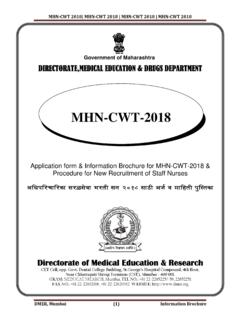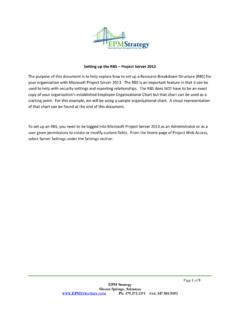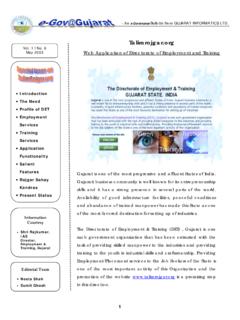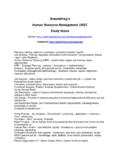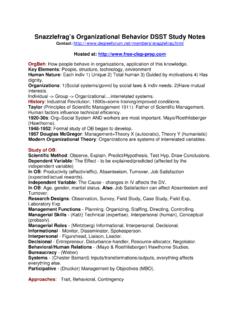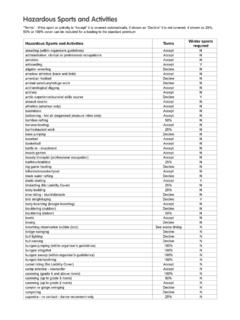Transcription of Modified Fantunes – Version 1 - Bridge Guys
1 Modified Fantunes Version IntroductionThis article describes a Version of the Fan-tunes system designed by Gerben Dirksen af-ter playing the almost classical Version in liveand online tournaments. It is largely basedon the system by Italian superstars FulvioFantoni and Claudio Nunes, nicknamed Fan-tunes. There are also some Polish Club ele-ments included. The system is very flexibleand most of all very advantage of the Fantunes system is ex-perienced in several ways. The extremelysolid 1-bids make both competetive and un-contested auctions much easier than standardopening bids because responder can bid morewith less and still control the auction. On theother hand, the 2-bids are very frequent andalthough they preempt the auction for us too,even more so for the bidding is not included in this Opening Bid StructureThe opening bid structure is very natural:1 13+5+ unbal. / 4=4=1=4 / 15+ 13+4+ unbal. (4 5 poss.)1 13+5+ 1 13+5+ 1NT 12 14 (semi)bal., 5422, 5M 9 12, 5+ 2 9 12, 5+ 2 9 12, 5+ 2 9 12, 5+ 2NT 20 21 balanced, 5M possibleThe most interesting feature of this system isthat the 1-level opening bids are forcing andunlimited.
2 The minimum required strengthis best described by the Rule of 22, thelength of the two longest suit added to theHCP is at least 22. If you prefer Zar evalua-tion, the minimum opening strength is abouthalf a level more than a standard minimumopening bid, at least 29 Zar. Oppositea 1-level opening bid a balanced 11-count oran unbalanced 10-count is usually enough toforce to a 1-bid you will categorize your handin one of the following strength classes: Anormal hand which is worth about 13 17points, a strong hand, worth about 18 20points, a semi game forcing hand or a on the 2-level can be approximatedby the rule of 18. Since these bids are locatedaround the average strength of a Bridge handthey are extremely frequent and yet the rangeis very small so that partner will usually havean idea about the potential of the Passed hand biddingBecause of the light openings responder shand is limited if it didn t open. There-fore there are some different responses to 1of a major with a passed hand.
3 In addition,hands with at least 5 4 in the majors andabout 11/12 HCP (at least rule of 20) are alsoopened on the 3rdseat the 2-level bids can be very wideranging, in principle 6 12 HCP. In this case2 / is 1-suited with a maximum. In 4thseat these bids show a typical 4thseat WeakTwo bid with about 11 13 1 opening bidThe opening bid 1 shows either a balancedhand with at least 15 HCP (possibly 5 332with 15 17 HCP), or an unbalanced handwith 4 or more Clubs. 4441-hands with ashort major should be opened 1 . 1 is un-limited and Responses to 1 1 0 5 any distributioninvitational without 4-card majormin. GF, 5 5, not both minors1 6+4+ , longer minor possible1 6+4+ , longer minor possible1NT 6 8 bal., no 4-card major2 GF, 5+ 2 GF, 5+ 2 5 + 4 , 5 82 6 8, 5+4+minorsor GF 5+5+minors2NT 14+balanced3 6 8, 6+ 3 6 8, 6+ 3 11 13 bal. no stopper in other M3NT 11 13 bal. stopper in + After 1 1 The 1 response can have several meaningsbut since it is weak or strong, opener canmake use of a wide-range 1NT rebid.
4 On the2-level there are several artificial rebids to fillthe gaps. Note that the 2 -rebid can show 6cards as minimum hands with 5 and 4 areopened with 1 .1 1 ?1 / 4+card, less than SGF(15 17 if balanced)1NT 15 19 balanced4-card major possible if 13 20, 6+ 2 24+bal. / GF2 SGF, not 6 42 18 20, 5+ 4 2NT 22 - 23 balanced3 Semiforcing, good 6+ 3x0 4 losers, 6+ 1 / rebidThis natural rebid shows an unbalanced handwith and the bid major. Responder canshow the different hand types in 1 on differ-ent levels: Weak hands with 0 5 HCP bid natu-rally, upto 2 . Invitational hands bid 2NT, 3 or 3 .Because the rebid promises at least 4cards in , 3 will be the most commoninvitational rebid. Strong 2-suiters are shown with higherrebids as naturally as possible: raisingpartner s major to the 3-level shows 5 5with a fit in the major, a bid in the othermajor shows that major and , confirm-ing the minor suit fit. The final combi-nation of the other major and 1NT rebidBecause of the different ranges of the possibil-ities in 1 a wide-range 1NT rebid is used (15 19 HCP).
5 Opener may have a 4-card major,or, if he has 15 17, 5 cards in . After thestrong 1NT rebid we use a different system asafter opening a weak 1NT, as opener shoulddeclare most of the time and because of thelarge limitation on the possible hands partnermight have. The most important restrictionis that responder is never invitational afterthis sequence as the invitational variation of1 (approx. 9 10 HCP) is a minimum GFafter the 1NT 1 1NT ?2 Stayman, 0 5 or GF 5+ 5+ 2 0 5, 5+ or GF 5+ 5 / 2 0 5, 5+ or GF 5+ 5 / 2 NT Transfer, 0 5 or min. GF3 Both minors, 0 53 Both minors, min. GF3 Min. GF, 3 , 0/1 3 Min. GF, 3 , 0/1 After the strong rebids 2 / 2 shows a semi-GF hand, 2 shows a GFhand (possibly balanced). Opener may nothave a 6 4 distribution. After these rebids,responder s cheapest response is a relay, ask-ing opener to describe his hand naturally:1 1 2 2 ?2 3-suited, 5 440 or 4=4=1=4(2NT asks for shortness)2NT Balanced, 23 253 6+ 3x5 4x3NT Balanced, 26+After the 2 -rebid and 2 relay there is nobalanced option and 2NT is now a 3-suitedhand, but only with -shortness.
6 4-loserhands with a major-suit shortness should re-bid 1 / , not 2 . After the strong 2 -rebidThis specific rebid shows a reverse-type handwith both minors. After this, 2NT forcesopener to bid 3 and responder will sign offin a minor or bid a stopper for 3NT. A direct3 / -bid by responder is natural and forcingand starts a slam investigation. 3 is natu-ral and to play and represents a 6- or 7-cardsuit, 3 shows the strong GF hand with Reverse Majors: 1 1 / After 1 / we invert the major suit re-sponses. The two main advantages of thisapproach are: The stronger hand, opener, will playmore often. This is especially true for1 where 1 / may be bid on 0 HCP,but also for 1 which may include a verystrong balanced hand. If you bid 1 to show the opponentshave one less bid available to show , onthe other hand after 1 showing theyhave one extra bid, but in this case wehave the master the response of 1 , 1 shows 4 cardsin , completing the inversion. This rebid ispreferred over a NT rebid with a traditionalstrong NT (15 17), but not with strongerhands.
7 Most other rebids are natural exceptfor the 2-level reverse bids. 2 is Odwrotka and a reverse in the other major has that the 3 -rebid covers a tough pos-sibility, the Bridge World Death Hand , aninvitation with 3-card 1 ( ) ?1 4+ , 15 17 if balanced, F1R1NT 15 17 balanced, no 4 ( )2 13 17, 6(5)+ 2 GF, 3+card support2 ( ) GF unbal. no 3-card support2 ( ) minimum, 3/4-card support2NT 18 19 / 22+bal. no 3 ( )3 Invite, 6 + 3-card support3 GF, 6+ + 4 3 ( ) GF, 6+ + 4 ( )3 ( ) Invite, 4-card support3NT Solid with stoppers4 GF, 5 4 ( ) 2 After the 1NT rebidAfter the 1NT rebid, 2-way Checkback is inplace. 2 is weak with or any invitationalhand, partner must bid 2 . GF hands rebid2 .31 1 1NT ?2 Weak or any invite2 GF ask for 3-card support2 5 4 , GF2 5-card , weak2NT Invite to 3NT with 4 3 To play3 Splinter for 3 Natural slam try3NT To play4 Splinter for Note that both direct bids in the other major,1 1 1NT 2 1 1 1NT 2 are natural (at least 5 4) and GF.
8 With a5 5 hand go through 2 first if nonforcing,nonforcing 5 4 would have either responded2 directly (with 5 ), or not have a 4 4 fit(with 5 ).After the forced 2 -bid, responder bids nat-urally:1 1 1NT 2 2 ?2 Invite with 5 5 2 Unbalanced invite2NT Invite to 3NT with 5 3 Invite with 4 5+ / After 1 1 1 As the may still be artificial in this auc-tion, 2 is an asking bid, mostly invitationalasking for 3-card support. With a strong GFhand and worries about minor suit stoppers(both minors as opener can have 3=4=4=2or similar), responder bids 2 , stopper 1 1 ?1NT Suggestion to play2 Checkback Stayman2 Asks for minor-suit stoppers2 NF, 4(3)-card support2 Invite, 6+ 2NT Invite to 3NT1 1 1 2 ?2 Minimum, 0 2 2 Balanced (GF), 3 2 Minimum, 3 2NT Balanced (GF), 2 3 GF, 6+ 3 GF, 5 , asks for stopper3 GF, 5 , 3 , splinter3NT GF, 5 , stopper in 1 1 1 2 ?2 stopper2 stopper2NT Both stoppers3 5-card Responder has a 6-card majorWith a 6-card major in response to 1 andopener s unbalanced rebid, with 6 9 HCP orso make a simple rebid after making a reversemajor bid.
9 A jump to the shown major isGF (for example 1 1 2 3 ). Thisshows less slam interest than going throughThird Suit Forcing or Fourth Suit BubrotkaIn the sequence 1 1 / 2 , openershows a GF hand and at least 3-card supportof partner s major. Partner will now bid likethis:2 6 9, 4 cards no 5m2 10+, 4 cards2NT 10+, 5+cards3 6 9, 5+card + 4M3 6 9, 5 6 9, 5 3323NT 6 9, 6+ 4 SplinterAfter the response to the relay, opener contin-ues naturally. This is especially useful to finda 4 4 fit in the other major. The other se-quence where Bubrotka is used is 1 1 / 1NT 2 2 . Here the 3 / responsesare a bit different: Instead of showing a minorside suit they show a fit in (see the relevantsection) Multi-Reverse 1 1M 2 MThis shows an unbalanced GF hand with lessthan 3 cards in partner s major. It also de-nies a 6 4 distribution or solid . Afterthis responder will describe his hand withoutmuch extra strength, or ask opener to do sowith a 2NT relay, which shows slam responds naturally to the relay:1 1M 2M 2NT ?
10 3 6+ 3 5 4 3M 6 4M3 oM 5 4M, 0/1 oM3NT 4M 2oM 2 5 2NT rebidThis shows a GF balanced hand with exactlya doubleton in partner s major, either 18 19 or 22+. It is preferred over rebidding 1 after 1 1 . Responder bids naturally inprinciple, but a bid in his long suit on the 3-level, for example 1 1 2NT 3 , isa range asking bid. A bid above responder ssuit is a cuebid setting his suit as After 1 1 NTAfter the 1NT rebid opener can bid naturally,or ask what responder has with the 2 to the relay is similar to the relayafter a weak NT:2 2 3 2 2 3 2NT 3 3 3 5 4 2 23 5 4 2 23 2236 bad 3 2263 bad After 2 / , 2NT asks again about the minorsuit distribution:3 5 3 5 3 6 bad 3 6 bad 3NT 4 4 After 2NT, 3 asks again, then:3 4 3 4 3 5 3NT 5 After 1 2 NTOpener will usually relay with 3 after whichresponder transfers to his major, or bids 3 with both minors. Other rebids by opener arenatural and show extreme Different responses with apassed handWith a passed hand responder cannot have aGF 1-suited hand anymore, so the responses2 and 2 show a weak two type hand witha 6-card suit, about 5 8 HCP.

